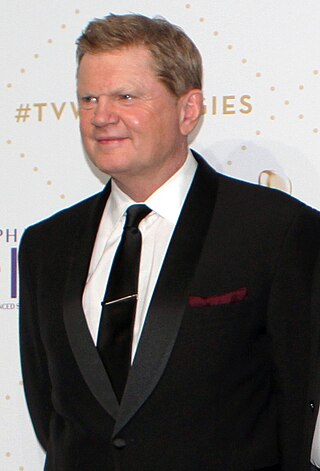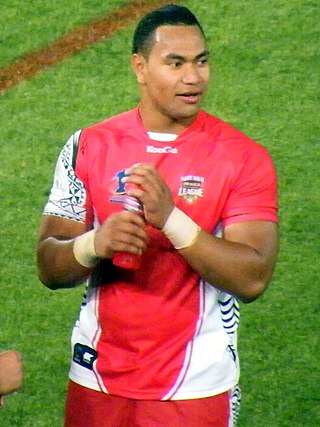Related Research Articles

Bill "Herman" Hamilton is an Australian former rugby league footballer who played in the 1960s and 1970s. Known as Herman by teammates after his resemblance to popular television character Herman Munster, he played in the New South Wales Rugby Football League premiership as a front rower for the Manly-Warringah and North Sydney clubs, winning the 1972 and 1973 premierships with the Sea Eagles. He also gained selection for the Australia on the 1973 Kangaroo Tour though he only played in eight minor matches and didn't play a test.

Paul Vautin, nicknamed Fatty, is an Australian football commentator and former professional rugby league footballer, captain and coach. He has provided commentary for the Nine Network's coverage of rugby league since joining the network in 1992 and also hosted The Footy Show from its beginnings in 1994 opposite co-host Peter Sterling, until 2017. An Australian Kangaroos test and Queensland State of Origin representative lock or second-row forward, Vautin played club football in Brisbane with Wests, before moving to Sydney in 1979 to play with Manly-Warringah, whom he would captain to the 1987 NSWRL premiership. He also played for Sydney's Eastern Suburbs, and in England for St Helens.

Harry Bath, born Alfred Henry Bath, also known by the nickname of "The Old Fox", was an Australian rugby league footballer and coach who was prominent and influential in the mid-20th century. A state and international representative who played 12 matches for Other Nationalities in the International Championship from 1949 to 1955, he played as a second-row and has been referred to as the best Australian rugby league player never to be picked for the Australian national team. Following his retirement, Bath coached in the New South Wales Rugby Football League premiership for two decades, also achieving selection as the Australian national team coach.

Graeme Christopher Hughes is an Australian sportsman turned broadcaster. He is the last man to have played both rugby league and cricket for New South Wales. His father Noel Hughes played cricket for Worcestershire in the 1950s.
Gene Miles is an Australian former rugby league footballer who played in the 1980s and 1990s. An Australian international and Queensland State of Origin representative centre, he played his club football in the Brisbane Rugby League premiership before joining the Brisbane Broncos in 1988 and later captained in 1990.
Kenneth Howard "Killer" Kearney was an Australian rugby footballer – a dual-code international player – and a rugby league coach. He represented the Wallabies in seven Tests, and the Kangaroos in thirty-one Test matches and World Cup games. He captained Australia in nine rugby league Test matches in 1956 and 1957. He was a hooker and captain-coach with the St. George Dragons in the first half of their eleven-year consecutive premiership winning run from 1956 to 1966. He is considered one of Australia's finest footballers of the 20th century.
Wally O'Connell OAM was an Australian rugby league footballer who played in the 1940s and 1950s, and coached in the 1950s, 1960s and 1970s. He was a five-eighth for the Australian national team. He played in ten Tests between 1948 and 1951 as captain on one occasion. Wally's younger brother Barry also played first grade football for Easts and Manly.
Ferris Arthur Ashton was an Australian rugby league footballer who represented his country in 8 test matches. Ferris was also a member of the Royal Australian Navy (RAN) during the Second World War.
Terry William "Igor" Randall is an Australian former rugby league footballer who played for the Manly-Warringah club in the New South Wales Rugby Football League premiership. He is regularly named in all-time great teams and polls. He also represented New South Wales and Australia. He began his career in 1970 as a Centre, but soon after in 1972 was switched to the forwards by coach Ron Willey, primarily playing in the second-row. His nickname was Igor.

Arthur James Summons was an Australian representative rugby union and rugby league player, a dual-code rugby international fly-half or five-eighth. He captained the Australian national rugby league team in five undefeated test matches from 1962 until 1964 and later also coached the side.

Noel Harvey "Crusher" Cleal is an Australian former professional rugby league footballer and coach. A destructive second-row for the Manly Sea Eagles, he also represented New South Wales in the State of Origin Series and the Australian national rugby league team.

Cliff Lyons is an indigenous Australian former international rugby league footballer who played in the 1980s and 1990s. A Clive Churchill Medallist and two-time Dally M Medallist, he made 309 first-grade appearances with the Manly Warringah Sea Eagles, winning grand finals with them in 1987 and 1996. Lyons also represented New South Wales and Australia, being part of the successful 1990 Kangaroo Tour of Great Britain and France.
1959's New South Wales Rugby Football League premiership was the 52nd season of the rugby league competition based in Sydney. Ten teams from across the city competed for the J. J. Giltinan Shield during the season, which culminated in a grand final between St. George and Manly-Warringah.
1957's New South Wales Rugby Football League premiership was the 50th season of the rugby league competition based in Sydney. Ten teams from across the city competed for the J. J. Giltinan Shield during the season, which culminated in a grand final between St. George and Manly-Warringah.

Roy Bull was an Australian rugby league footballer who played in the 1940s and 1950s and spent his whole career – as player, coach & administrator – with the Manly-Warringah club in Sydney. In addition to playing in three New South Wales Rugby Football League premiership grand finals, he was a representative for the New South Wales rugby league team and the Australian national side. He has since been named amongst the nation's finest footballers of the 20th century.
The 1987 NSWRL season was the 80th season of professional rugby league football in Australia. Thirteen clubs competed for the New South Wales Rugby League premiership's J J Giltinan Shield and Winfield Cup during the season, which culminated in the grand final between the Manly-Warringah Sea Eagles and the Canberra Raiders who were the first club ever from outside Sydney to appear in a premiership decider. This season, NSWRL teams also competed for the 1987 National Panasonic Cup.
John "Rupert" Mudge (1928–1993) was an Australian rugby union and rugby league footballer who played in the 1940s and 1950s. He played both rugby codes in Sydney, New South Wales as well as playing rugby league in England. Rupert John Mudge played for the Randwick rugby union club in his junior years before being recruited by English rugby league club, Workington Town, where he was joined by fellow Australian recruit Tony Paskins. While in England, he played at representative level for British Empire and Other Nationalities.

Tony Williams, also known by the nickname of "T-Rex", is a former professional rugby league footballer. He played for both Tonga and Australia at international level.
The 1986 Kangaroo tour of Great Britain and France was the sixteenth Kangaroo tour in which the Australian national rugby league team plays a number of tour matches against British and French teams, in addition to the Test matches. The next Kangaroo tour was staged in 1990.
The 1959–60 Kangaroo tour was the tenth Kangaroo tour, in which the Australian national rugby league team traveled to Europe and played thirty-seven matches against British, French and Italian teams, including the Ashes series of three Test matches against Great Britain, two Test matches against the French and an additional two non-Test matches against an Italian representative team. It followed the tour of 1956-57 and the next was staged in 1963-64.
References
- ↑ "Statistics at rugbyleagueproject.org". rugbyleagueproject.org. 31 December 2017. Retrieved 1 January 2018.
- ↑ Goodman, Tom (28 May 1959). "Queensland beats N.S.W. in league by 17-15". The Sydney Morning Herald . Retrieved 11 December 2011.
- ↑ Toby Creswell and Samantha Trenoweth (2006). 1001 Australians You Should Know. Australia: Pluto Press. p. 693. ISBN 9781864033618.
- ↑ ARL Annual report 2005, page 54
- 1 2 3 "Daughter and Keeper of the Buzo Flame". The Sydney Morning Herald. 27 July 2007. Retrieved 18 June 2011.
Year after year Buzo, ...faithfully recorded the Mossopisms that tripped off the great caller's tongue,
- 1 2 Buzo, Alex (20 September 2001). 3rd Annual Tom Brock Lecture : Sydney: Heart of Rugby League (PDF) (1st ed.). Sydney: Tom Brock Bequest Committee/ Australian Society for Sport History. p. 12. ISBN 0-7334-1951-8 . Retrieved 18 June 2011.
From 1977 to 1983 I ran a tautology tournament in the The National Times... Rex Mossop won every year, ...
- ↑ A sad day for Rugby League - Rex Mossop passed away... Archived 3 October 2011 at the Wayback Machine , sportal.com.au, Tim Mander (7 April 2008), accessed 22 June 2011
- ↑ Sydney Showground Speedway
- ↑ 1982 Speedway World Pairs Final - Heat 1
- ↑ "Beauty and the Beast (1970-1971)". IMDb . Retrieved 19 June 2011.
- ↑ "Vale Rex Mossop – The Moose who roared". The Roar. 18 June 2011. Retrieved 21 April 2015.
- ↑ Buzo, Alex (20 September 2001). 3rd Annual Tom Brock Lecture : Sydney: Heart of Rugby League (PDF) (1st ed.). Sydney: Tom Brock Bequest Committee/ Australian Society for Sport History. p. 13. ISBN 0-7334-1951-8 . Retrieved 18 June 2011.
- ↑ "Tonight Live with Steve Vizard". Seven Network (via YouTube). 29 October 1992. Retrieved 17 April 2022.
- ↑ "It's An Honour, Australian Sports Medal - MOSSOP, Rex". itsanhonour.gov.au. 24 October 2000. Retrieved 18 June 2011.
- ↑ NSW Registry Birth Death & Marriages ; Marriage Reference No. 24183/1951. District of Manly.
- ↑ Rex Mossop: Rugby league player who became a-love-him-or-loathe-him commentator The Independent 16 July 2011
- ↑ "Manly legend Rex Mossop dies aged 83". The Sydney Morning Herald. 18 June 2011. Retrieved 18 June 2011.
- ↑ "Vale Rex Mossop" Archived 6 October 2011 at the Wayback Machine